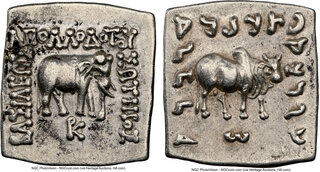| Heritage World Coin Auctions > Showcase Auction 61388 | Auction date: 14 May 2024 |
| Lot number: 23123 Price realized: This lot is for sale in an upcoming auction - Bid on this lot  | Show similar lots on CoinArchives Find similar lots in upcoming auctions on |
| Lot description: Ancients INDO-GREEK KINGDOMS. Bactria. Apollodotus I Soter (ca. 174-165 BC). AR Indic square drachm (15mm, 2.45 gm, 12h). NGC Choice XF 5/5 - 3/5, brushed. Indian standard. Uncertain mint in the Paropamisadai or Gandhara. ΒΑΣΙΛΕΩΣ-ΑΠΟΛΛΟΔΟΤΟΥ-ΣΩΤΗΡΟΣ, elephant standing right, head slightly facing; KP monogram in exergue / Maharajasa Apaladatasa tradarasa (Kharosthi), zebu standing right; w in exergue. Bopearachchi 4e. HGC 12, 119 (ca. 174-165 BC). The charismatic square drachm of Apollodotus I Soter presents an intriguing puzzle for interpreting the symbolic meanings of animals across Vedic, Buddhist, and Greek cultural contexts. The coin features the zebu, a cattle species native to the Indian subcontinent, revered in Vedic spirituality. This animal is deeply intertwined with the Hindu deity Shiva as Nandi, his sacred bull, which is omnipresent across Shivan temples in India. The elephant likewise symbolizes royal authority and wisdom, notably embodied by the deity Ganesha. Both animals also have a place in the story of the birth of Buddha, where the Buddha's mother Queen Maya saw a white elephant in a dream, and then gave birth to the Buddha under a Taurus full moon. The elephant had been adopted by the coinage of eastern Greek kingdoms, including by the Seleucids and Bactria, as a powerful symbol of military might. The zebu, a type of bull, may have been associated with Zeus. https://coins.ha.com/itm/ancients/greek/ancients-indo-greek-kingdoms-bactria-apollodotus-i-soter-ca-174-165-bc-ar-indic-square-drachm-15mm-245-gm-1/a/61388-23123.s?type=DA-DMC-CoinArchives-WorldCoins-61388-05142024 HID02906262019 © 2024 Heritage Auctions | All Rights Reserved |  |



